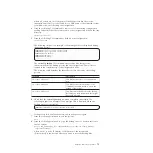
You can restore the configuration by using any node as the configuration node.
However, if you do not use the node that was the configuration node when the
system was first created, the unique identifier (UID) of the volumes that are within
the I/O groups can change. This action can affect IBM Tivoli
®
Storage Productivity
Center for Fabric, VERITAS Volume Manager, and any other programs that record
this information.
The Storwize V7000 analyzes the backup configuration data file and the system to
verify that the required disk controller system nodes are available.
Before you begin, hardware recovery must be complete. The following hardware
must be operational: hosts, Storwize V7000, drives, the Ethernet network, and the
SAN fabric.
Backing up the system configuration using the CLI
You can back up your configuration data using the command-line interface (CLI).
Before you back up your configuration data, the following prerequisites must be
met:
v
No independent operations that change the configuration can be running while
the backup command is running.
v
No object name can begin with an underscore character (_).
v
The default object names for controllers, I/O groups, and managed disks
(MDisks) do not restore correctly if the ID of the object is different from what is
recorded in the current configuration data file.
v
All other objects with default names are renamed during the restore process. The
new names appear in the format
name
_r.
where
name
is the name of the object in your system.
The backup feature of the
svcconfig
CLI command is designed to back up
information about your system configuration, such as volumes, local Metro Mirror
information, local Global Mirror information, managed disk (MDisk) groups, and
nodes. All other data that you have written to the volumes is
not
backed up. Any
application that uses the volumes on the system as storage, must back up its
application data using the appropriate backup methods.
You must regularly back up your configuration data and your application data to
avoid data loss. If a system is lost after a severe failure occurs, both configuration
of the system and application data is lost. You must reinstate the system to the
exact state it was in before the failure, and then recover the application data.
The SSH coding examples that are provided are samples using the PuTTY scp
(pscp) application code. The pscp application is available when you install an SSH
client on your host system. You can access the pscp application through a
Microsoft Windows command prompt.
Perform the following steps to back up your configuration data:
1.
Back up all of the application data that you have stored on your volumes using
your preferred backup method.
2.
Open a command prompt.
3.
Using the command-line interface, issue the following command to log on to
the system:
plink -i
ssh_private_key_file
superuser@
cluster_ip
72
Storwize V7000: Troubleshooting, Recovery, and Maintenance Guide
Содержание Storwize V7000
Страница 1: ...IBM Storwize V7000 Version 6 3 0 Troubleshooting Recovery and Maintenance Guide GC27 2291 02...
Страница 6: ...vi Storwize V7000 Troubleshooting Recovery and Maintenance Guide...
Страница 8: ...viii Storwize V7000 Troubleshooting Recovery and Maintenance Guide...
Страница 10: ...x Storwize V7000 Troubleshooting Recovery and Maintenance Guide...
Страница 34: ...18 Storwize V7000 Troubleshooting Recovery and Maintenance Guide...
Страница 42: ...26 Storwize V7000 Troubleshooting Recovery and Maintenance Guide...
Страница 80: ...64 Storwize V7000 Troubleshooting Recovery and Maintenance Guide...
Страница 128: ...112 Storwize V7000 Troubleshooting Recovery and Maintenance Guide...
Страница 156: ...140 Storwize V7000 Troubleshooting Recovery and Maintenance Guide...
Страница 166: ...150 Storwize V7000 Troubleshooting Recovery and Maintenance Guide...
Страница 171: ......
Страница 172: ...Printed in USA GC27 2291 02...






























